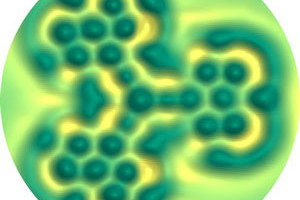
Unter dem Rasterkraftmikroskop, dem Atomic Force Microscope (AFM), haben Wissenschaftler von IBM Research in Zürich und dem Centro de Investigación en Química Biolóxica e Materiais Moleculares (CiQUS) der Universität von Santiago de Compostela erstmals die Struktur von Arinen abgebildet und damit deren Existenz auch direkt nachweisen können.

Arine gehören zu einer Klasse von sehr kurzlebigen und reaktionsfreudigen Molekülen. Die Forschungsarbeit ist ein weiterer eindrücklicher Beleg für das Potenzial der von den IBM Forschern entwickelten AFM-Methode, um chemische Strukturen von Molekülen abzubilden. In der Oberflächenchemie und Nanoelektronik eröffnet sie ein neues Spektrum an Anwendungsmöglichkeiten, etwa zur Herstellung von Graphen-Nanobändern oder die Synthese neuartiger Bauteile aus einzelnen Molekülen.
There are trillions of molecules in the universe and some of them are stable enough to be isolated and characterized, but many others are so short-lived that they can only be proposed indirectly via chemical reactions or spectroscopic methods.
One such species are arynes, which were first suggested in 1902, and since then have been used as intermediates or building blocks to synthesize a variety of compounds for applications including medicine, organic electronics and molecular materials. The challenge with these particular molecules is that they only exist for several milliseconds, making them extremely difficult to image. Until now.
Today the peer-reviewed journal Nature Chemistry has published the imaging of a single aryne molecule for the first time. This work is the result of a joint effort by CiQUS researchers in Santiago, who are experts in aryne chemistry, and the IBM team in Zurich, who have developed new atomic-resolution microscopy techniques.
“Arynes are discussed in almost every undergraduate course on organic chemistry around the world. Therefore, it’s kind of a relief to have finally confirmed that these molecules truly exist,” said Prof. Diego Peña, a chemist at the University of Santiago de Compostela. “I look forward to seeing new chemical challenges solved by the combination of organic synthesis and AFM.”
After the preparation of the key aryne precursor by CiQUS, IBM scientists used the sharp tip of a scanning tunneling microscope (STM) to generate individual aryne molecules from precursor molecules by atomic manipulation. The experiments were performed on films of sodium chloride at temperatures near absolute zero to stabilize the aryne. Once the molecules were isolated, the team used atomic force microscopy (AFM) to measure the tiny forces between the tip, which is terminated with a single carbon monoxide molecule, and the sample to image the aryne’s molecular structure. The resulting image was so clear that the scientists were able to study their chemical nature based on the minute differences between individual bonds.
“The IBM team has developed several state-of-the-art techniques since 2009 that made this achievement possible,” said Dr. Niko Pavliček, a physicist at IBM Research. “For this study it was absolutely essential to pick an insulating film on which the molecules were adsorbed and to deliberately choose the atomic tip-terminations to probe them. We hope this technique will have profound effects on the future of chemistry and electronics.”

This work is a result of the large European project called PAMS (Planar Atomic and Molecular Scale Devices). PAMS’ main objective is to develop and investigate novel electronic devices of nanometric-scale size. Part of this research is funded by a European Research Council Advanced Grant awarded to IBM scientist Dr. Gerhard Meyer, who is also a co-author of the paper. These prestigious grants support “the very best researchers working at the frontiers of knowledge” in Europe.
IBM Research and CiQUS have previously collaborated and published papers on differentiating the chemical bonds in individual molecules and imaging high-quality nanographenes generated from easily available organic compounds.
This research is part of IBM’s five-year, $3 billion investment to push the limits of chip technology and semiconductor innovations needed to meet the emerging demands of cloud computing and Big Data systems.
The results of this research also reinforce one the main research lines of CIQUS, which is devoted to developing bottom-up approaches to molecular-scale electronics.
The STM and its offspring the AFM are the two workhorses of atomic and molecular-scale research. The STM, which was invented by Gerd Binnig and Heinrich Rohrer at IBM Research – Zurich in 1981, allowed scientists for the first time to image individual atoms on a surface. The revolutionary microscope, for which the two scientists received the 1986 Nobel Prize in physics, has expanded the boundaries of our knowledge by revealing the properties of surfaces and molecules or atoms adsorbed thereon with atomic resolution.
http://www.zurich.ibm.com/news/15/molecules.html
